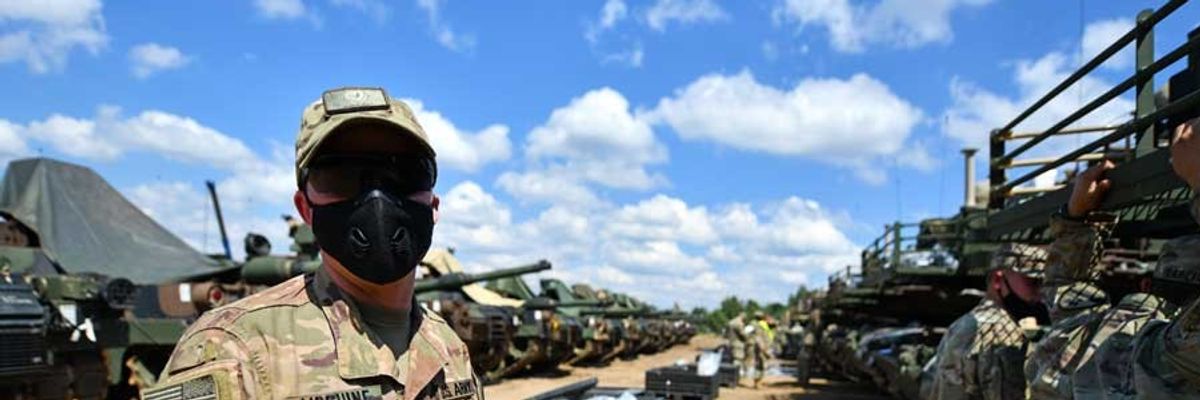Alarm is growing throughout NATO governments and the Western media about Russia’s continuing, multifaceted military buildup in its Kaliningrad enclave between Poland and Lithuania.
It’s not an entirely new concern. In the spring of 2018, satellite imagery indicated that Moscow was upgrading a nuclear-weapons storage bunker there. Another report in October of that year, also based on satellite images, confirmed that the Russians were upgrading four other military installations. One of the reasons that the Trump administration cited for withdrawing the United States from the Intermediate Nuclear Forces treaty was that the Kremlin had developed a new missile, the 9M729, which allegedly violated the treaty’s restrictions on range and other capabilities. As early as 2017, some of those controversial missiles were deployed to Kaliningrad.
The missile deployment was not, and is not, the extent of Moscow’s military buildup there. In both 2019 and 2020, there was an influx of drones, battle tanks, fighter planes, and additional personnel. Early this month, the Russian news agency TASS reported that a new division consisting of infantry, armored, and artillery regiments would be deployed on Kaliningrad’s border with NATO member Lithuania.
An enclave that already harbored substantial firepower before 2017 is now bristling with weaponry and has become a major center of Russian military power. Kaliningrad’s location embodies both potential vulnerability and potential menace. An awkward territorial legacy from the end of the Cold War and the dissolution of the Soviet Union, Kaliningrad is sandwiched between southwestern Lithuania and northern Poland, and the territory is separated from the rest of Russia by several hundred miles of foreign territory. In one sense, it would be nearly impossible for Russia to defend the isolated enclave from a concerted NATO military offensive. At the same time, though, the troops, tanks, and especially the missiles, could do considerable damage to NATO forces, and the massive deployment undoubtedly looks threatening to a small, weak country like Lithuania.
Vladimir Putin’s government defends the Kaliningrad buildup as a response to NATO’s increasingly menacing behavior along the borders of the Russian Federation. Unfortunately, that justification has some merit. NATO has engaged in an alarming number of provocations in recent years. The political decision to expand the alliance to incorporate not only the members of the defunct Warsaw Pact, but also the three Baltic states that had been part of the USSR, was itself a decidedly unfriendly act. But NATO has engaged in a number of specific military actions that have exacerbated tensions.
The number and size of NATO military exercises along Russia’s western frontier have surged in recent years. Indeed, in January 2020, the alliance conducted its largest exercise in 25 years. In early June, Russia offered to scale-back its maneuvers for the duration of the coronavirus outbreak, if the Western allies did likewise. Russian military leaders complained that NATO simply “stonewalled” the offer.
In addition to the proliferation of NATO “war games,” there has been a dramatic increase in the number of incidents in which NATO aircraft — especially U.S. reconnaissance planes — have approached the Russian border to test the country’s air and sea defenses. Moscow has reacted angrily to such conduct, not only intercepting those aircraft but “buzzing” them and engaging in other unsafe practices. There have been dozens, if not hundreds, of interceptions of U.S. and NATO military planes annually in recent years, principally in the Black Sea and Baltic Sea regions. Russian warships also have shadowed their NATO counterparts, and Russian planes have repeatedly buzzed and harassed U.S. and NATO ships.
Although both sides can be faulted for such destabilizing behavior, the Western powers deserve the bulk of the blame. As ABC News noted in an April 2020 investigation, many of the close encounters have been in and around the Baltic Sea. Granted, Russian aircraft have sometimes conducted aerial probes near the borders of NATO’s European members (and even U.S. territory, especially near Alaska). Nevertheless, the number of such incidents is dwarfed by the extent of U.S. and NATO military activity along Russia’s borders. The undeniable reality is that the United States and its NATO allies are crowding Russia, and the Kremlin’s Kaliningrad military posture must be seen in that context. As early as 2015, Russian officials warned that they would match any NATO buildup, including by making additional deployments to Kaliningrad.
Washington’s policies have been especially unhelpful. The decision to build a military facility in Poland (which the country’s president once offered to name “Fort Trump”) was gratuitously provocative. Washington even managed to transform the decision to withdraw some 11,900 U.S. troops from Germany, which Moscow might have perceived as a conciliatory gesture, into a provocation. Transferring more than 1,000 of those forces eastward to establish a permanent U.S. troop presence in Poland conveyed a markedly unfriendly message.
Tensions between NATO and the Kremlin are now at their worst level since the demise of the Soviet Union, and both sides need to take reparative steps. Since most of the provocations have come from NATO, the Western powers must make the first conciliatory moves. The United States and its allies should impose a moratorium on NATO war games near Russia — especially in the Baltics and eastern Poland. Washington also must end the fiction that its constant rotational deployments of U.S. military forces in Eastern Europe do not constitute a “permanent” presence. Russia would need to draw back its forces from its western border with NATO members, especially the Baltic republics, and reverse its missile buildup and other deployments in Kaliningrad.
That is hardly a definitive list of the measures needed for a genuine “reset” in NATO-Russian relations, but it would be a good beginning. The alternative is to let already worrisome tensions grow even worse. At that point, Kaliningrad could become the detonator for a new, horrific European war.
















